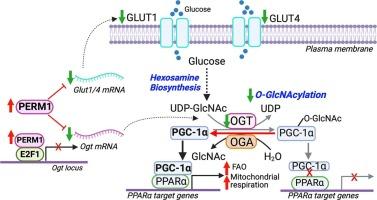PERM1 regulates mitochondrial energetics through O-GlcNAcylation in the heart
IF 4.7
2区 医学
Q1 CARDIAC & CARDIOVASCULAR SYSTEMS
引用次数: 0
Abstract
PERM1 was initially identified as a new downstream target of PGC-1α and ERRs that regulates mitochondrial bioenergetics in skeletal muscle. Subsequently, we and other groups demonstrated that PERM1 is also a positive regulator of mitochondrial bioenergetics in the heart. However, the exact mechanisms of regulatory functions of PERM1 remain poorly understood. O-GlcNAcylation is a post-translational modification of proteins that are regulated by two enzymes: O-GlcNAc transferase (OGT) that adds O-GlcNAc to proteins; O-GlcNAcase (OGA) that removes O-GlcNAc from proteins. O-GlcNAcylation is a powerful signaling mechanism mediating cellular responses to stressors and nutrient availability, which, among other targets, may influence cardiac metabolism. We hypothesized that PERM1 regulates mitochondrial energetics in cardiomyocytes through modulation of O-GlcNAcylation. We found that overexpression of PERM1 decreased the total levels of O-GlcNAcylated proteins, concomitant with decreased OGT and increased OGA expression levels. Luciferase gene reporter assay showed that PERM1 significantly decreases the promoter activity of Ogt without changing the promoter activity of Oga. The downregulation of OGT by PERM1 overexpression was mediated through its interaction with E2F1, a known transcription repressor of Ogt. A deliberate increase of O-GlcNAcylation through Oga silencing in cardiomyocytes decreased the basal and maximal mitochondrial respiration and ATP production rates, all of which were completely restored by PERM1 overexpression. Furthermore, excessive O-GlcNAcylation caused by the loss of PERM1 led to the increase of O-GlcNAcylated PGC-1α, a master regulator of mitochondrial bioenergetics, concurrent with the dissociation of PGC-1α from PPARα, a well-known transcription factor that regulates fatty acid β-oxidation. We conclude that PERM1 positively regulates mitochondrial energetics, in part, via suppressing O-GlcNAcylation in cardiac myocytes.

PERM1 通过 O-GlcNAcylation 调节心脏线粒体能量
PERM1 最初被确定为 PGC-1α 和ERRs 的一个新下游靶点,可调节骨骼肌线粒体的生物能。随后,我们和其他研究小组证实,PERM1 也是心脏线粒体生物能的正向调节因子。然而,人们对 PERM1 调节功能的确切机制仍然知之甚少。O-GlcNAcylation 是蛋白质的一种翻译后修饰,由两种酶调节:O-GlcNAc转移酶(OGT)将O-GlcNAc添加到蛋白质中;O-GlcNAcase(OGA)将O-GlcNAc从蛋白质中去除。O-GlcNAcylation 是一种强大的信号机制,可介导细胞对应激源和营养供应的反应,除其他目标外,它还可能影响心脏的新陈代谢。我们假设 PERM1 通过调节 O-GlcNAcylation 来调节心肌细胞线粒体的能量。我们发现,过表达 PERM1 会降低 O-GlcNAcylated 蛋白的总水平,同时降低 OGT 和提高 OGA 的表达水平。荧光素酶基因报告实验表明,PERM1 能显著降低 Ogt 的启动子活性,而不改变 Oga 的启动子活性。PERM1 过表达对 OGT 的下调是通过其与已知的 Ogt 转录抑制因子 E2F1 的相互作用来介导的。 通过沉默 Oga 故意增加心肌细胞中的 O-GlcNAcylation 会降低线粒体的基础呼吸率和最大呼吸率以及 ATP 生成率,而 PERM1 过表达则可完全恢复这些呼吸率和 ATP 生成率。此外,PERM1 的缺失导致的过度 O-GlcNAcylation 增加了线粒体生物能的主要调节因子 PGC-1α 的 O-GlcNAcylated,同时 PGC-1α 与 PPARα 分离,而 PPARα 是众所周知的调节脂肪酸 β 氧化的转录因子。我们的结论是,PERM1 部分通过抑制心肌细胞中的 O-GlcNAcylation 积极调节线粒体能量。
本文章由计算机程序翻译,如有差异,请以英文原文为准。
求助全文
约1分钟内获得全文
求助全文
来源期刊
CiteScore
10.70
自引率
0.00%
发文量
171
审稿时长
42 days
期刊介绍:
The Journal of Molecular and Cellular Cardiology publishes work advancing knowledge of the mechanisms responsible for both normal and diseased cardiovascular function. To this end papers are published in all relevant areas. These include (but are not limited to): structural biology; genetics; proteomics; morphology; stem cells; molecular biology; metabolism; biophysics; bioengineering; computational modeling and systems analysis; electrophysiology; pharmacology and physiology. Papers are encouraged with both basic and translational approaches. The journal is directed not only to basic scientists but also to clinical cardiologists who wish to follow the rapidly advancing frontiers of basic knowledge of the heart and circulation.

 求助内容:
求助内容: 应助结果提醒方式:
应助结果提醒方式:


